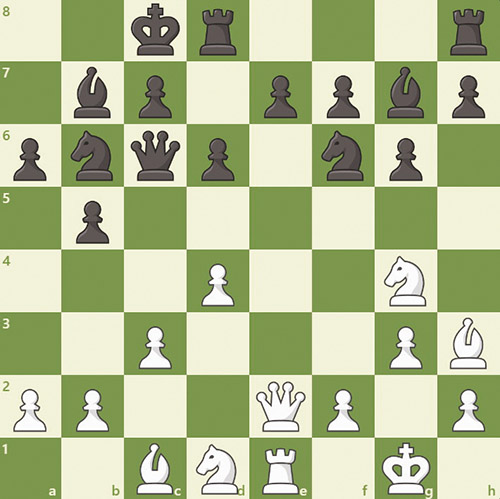
Editor’s note: We welcome Ethan Feder as a bimonthly chess columnist. With “The Link’s Gambit,” he seeks to provide both educational and entertaining chess content for individuals of all skill levels through explaining important concepts, high-level games, and relevant puzzles.
Welcome to my first column in The Jewish Link. As a chess enthusiast and competitor (I play online, as a top board for the school team and in tournaments, most recently in the New Jersey Grade Chess Championship), it’s my goal to follow in the footsteps of many chess columnists and share my love of the game. In each column I will discuss a new kind of chess tactic, strategy or idea. This week I will explain a significant chess concept: the discovered attack.
A discovered attack is a move in chess in which the movement of one piece opens up an attack from another piece that was previously blocked and forces the opponent to respond, as seen in the position above. White is down 6 points of material and black has the Queen and Bishop threatening white’s King, but white has the key move, Knight to e5, which both attacks black’s Queen and opens up the Bishop on h3 to check black’s King on c8. Black is forced to respond to the check and if he moves his King or blocks, the Knight then takes black’s Queen and white is winning. See if you can find the discovered check used in Jan Krzysztof Duda’s exceptional checkmate below and the presence of this idea in both of the puzzles.

This position is from the recent Meltwater Champions Chess Tour with Grandmaster Jan Krzysztof Duda with the white pieces playing against Grandmaster Anish Giri with black. Here, Duda uncorked a brilliant forced checkmate in 11 moves and soundly defeated Giri; feel free to take a moment to see if you can find the first move yourself. Duda begins the mating sequence with Rg7+, a shocking move giving up his Rook and forcing black’s King to take a step forward towards whites pieces. Giri responded Kxg7, followed by f6+ by Duda, bringing Giri’s King even closer with Kh6, and if he goes back to the g8 square, Duda checkmates him even faster with a Bishop sacrifice on h7 (30.Bh7+Kxh7 31.Qh5+ Kg8 32.Qg5+ Kh7 33.Qg7#). After Kh6, Ng4+ and Kg5, you should once again take a moment to find the only incredible move that wins for white. Duda played the brilliant Qf5+, sacrificing his Queen to the forced Nxf5. This Queen sacrifice, which he had seen since the move Rg7+, allows Duda to play Rxf5+, forcing the black King to either take white’s Knight on g4, which allows h3 checkmating the King or to go back with Kg6, which was played in the game. However, this then lines up the King with white’s Bishop on b1, allowing a discovered check from the Bishop on b1, forcing black to respond to the check instead of a Rook move. Here Duda played Re5+, after which Giri resigned because the discovered attack from the Bishop forces black to block the check with Rc2 34.Bxc2+ Qe4 35.Bxe4+ and the King must move to f7. Following Kf7 is Re7+ Kg8 37.Nh6+ Kh8 38.Rh7#, completing the 11-move checkmating sequence that Duda had foreseen when he played Rg7+, despite only having a few minutes on the clock.
Find the subtle only move that gives white an advantage from my own game at the New Jersey Grade Chess Championship
The move here is the quiet Queen to c1, and the reasoning behind this is actually tied to discovered attacks. Qc1 disallows a Queen trade and keeps black’s Queen stuck on the d file from which it can’t escape, which is significant because of the rook on d1. If the opponent moves it back with Qd7, the move my opponent played, white has the discovered attack Ndxe4 both takes blacks e pawn and opens up the Rook to the Queen, preventing black from immediately recapturing the Knight. If the Queen is kept on d3, black cannot prevent the ultimate loss of their Queen.
Ladislav Dobrovolsky vs. Frantisek Jablonicky, Tatry Open (2001)

Find the strongest winning move for white (the entirety of this game can be found on chessgames.com).
Here, it is best for white to move the pawn to f4, a discovered attack that hits the Bishop on e5 with the pawn and opens white’s Bishop on g2 against black’s rook on d1. If black captures white rook on d1, white simply recaptures and if black moves their Bishop away from danger, white plays Bishop to d5, attacking black’s Queen, which can’t move because it is pinned to the King.
Ethan Feder is a junior at Yeshivat Frisch, a chess enthusiast and player. The goal of his column is to teach and discuss chess concepts through example positions, high-level games and relevant puzzles, along with explanations. Feel free to contact him with any questions, suggestions or comments at ethan.feder@gmail.com.












